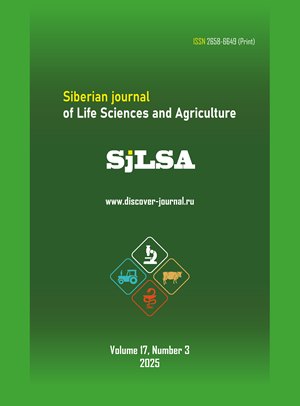Влияние низких температур и осмотического стресса на рост молочнокислых бактерий
Аннотация
Обоснование. На сегодняшний день использование молочнокислых бактерий не нашло широкого промышленного применения при производстве рыбных продуктов. В то же время, научное направление, связанное с разработкой и применением бактериальных культур при переработке продукции гидробионтов, обладает высокой актуальностью. Производственные процессы, связанные с переработкой рыбы, зачастую предусматривают применение высоких концентраций поваренной соли и низких положительных температур, которые ингибируют рост и развитие большинства микроорганизмов. Поэтому при создании бактериальных культур, предназначенных для производства рыбных продуктов, важным этапом исследований является изучение устойчивости применяемых штаммов к воздействию неблагоприятных факторов. Бактерии вида Latilactobacillus sakei имеют большие перспективы использования в качестве бактериальных культур при производстве рыбных продуктов в связи с высокой биохимической активностью и потенциальными пробиотическими свойствами.
Целью исследования являлось изучение устойчивости молочнокислых бактерий вида Latilactobacillus sakei к высоким концентрациям хлорида натрия и низким температурам.
Материалы и методы. Объектами исследования являлись четыре штамма бактерий вида Latilactobacillus sakei. Культивирование молочнокислых бактерий проводили на полужидкой среде MRS при температуре 37 °С. Способность бактерий расти в присутствии хлорида натрия определяли на полужидкой среде MRS с содержанием 12 % поваренной соли, а толерантность бактерий к низким положительным температурам изучали при культивировании штаммов при температуре 8 °С.
Результаты. В результате проведенных исследований доказано, что штаммы Llb. sakei LSK-45, Llb. sakei LSK-104, Llb. sakei LSK-103 способны расти при высоком содержании в питательной среде поваренной соли (12 %) и при низких положительных температурах.
Заключение. Установлено, что применение штаммов Llb. sakei LSK-45, LSK-104, LSK-103 в составе бактериальных культур для рыбоперерабатывающей промышленности представляет большой научный интерес.
EDN: ECLXVD
Скачивания
Литература
Никифорова, А.П., Хазагаева, С.Н. & Артюхова, С.И. (2019). Исследование биохимической активности штамма Lactobacillus sakei LSK-104. Вестник ВСГУТУ, 4(75), 62-68. EDN: https://elibrary.ru/arivmh
Никифорова, А.П. (2020). Перспективы производства ферментированных рыбных продуктов с использованием молочнокислых бактерий. Технологии пищевой и перерабатывающей промышленности АПК — продукты здорового питания, 2, 17-24. https://doi.org/10.24411/2311-6447-2020-10038 EDN: https://elibrary.ru/zejayp
Олескин, А.В. (2009). Биосоциальность одноклеточных (на материале исследований прокариот). Журнал общей биологии, 70(3), 225-238. EDN: https://elibrary.ru/kavohr
Ammor, S., Dufour, E., Zagorec, M., Chaillou, S. & Chevallier, I. (2005). Characterization and selection of Lactobacillus sakei strains isolated from traditional dry-sausage. Food Microbiology, 22, 529-538. https://doi.org/10.1016/j.fm.2004.11.016
Bonaccio, M., Ruggiero, E., Castelnuovo, A.D., Costanzo, S., Persichillo, M., Curtis, A.D. & Iacoviello, L. (2017). Fish intake is associated with lower cardiovascular risk in a Mediterranean population: Prospective results from the Molisani study. Nutrition, Metabolism and Cardiovascular Diseases, 27, 865-873. https://doi.org/10.1016/j.numecd.2017.08.004
Chai, H.J., Wu, C.J., Yang, S.H., Li, T.L. & Pan, B.S. (2016). Peptides from hydrolysate of lantern fish (Benthosema pterotum) proved neuroprotective in vitro and in vivo. Journal of Functional Foods, 24, 438-449. https://doi.org/10.1016/j.jff.2016.04.009
Chaillou, S., Champomier-Vergès, M.C., Cornet, M., Crutz Le Coq, A.M., Dudzé, A.M., Martin, V., Beaufils, S., Bossy, R., Darbon-Rongère, E., Loux, V. et al. (2005). Complete genome sequence of the meat-borne lactic acid bacterium Lactobacillus sakei 23K. Nature Biotechnology, 23, 1527-1533. https://doi.org/10.1038/nbt1160
Chen, J., Jayachandran, M., Bai, W. & Xu, B. (2022). A critical review on the health benefits of fish consumption and its bioactive constituents. Food Chemistry, 369, 130874. https://doi.org/10.1016/j.foodchem.2021.130874 EDN: https://elibrary.ru/fjsqlf
Gao, X., Kong, J., Zhu, H., Mao, B., Cui, S. & Zhao, J. (2022). Lactobacillus, Bifidobacterium and Lactococcus response to environmental stress: Mechanisms and application of cross-protection to improve resistance against freeze-drying. Journal of Applied Microbiology, 132, 802-821. https://doi.org/10.1111/jam.15251 EDN: https://elibrary.ru/hezagp
Gu, Y., Li, B., Tian, J., Wu, R. & He, Y. (2018). The response of LuxS/AI-2 quorum sensing in Lactobacillus fermentum 2-1 to changes in environmental growth conditions. Annals of Microbiology, 68, 287-294. https://doi.org/10.1007/s13213-018-1337-z EDN: https://elibrary.ru/llqblr
Van de Guchte, M., Serror, P., Chervaux, C., Smokvina, T., Ehrlich, S.D. & Maguin, E. (2002). Stress responses in lactic acid bacteria. Antonie van Leeuwenhoek, International Journal of General and Molecular Microbiology, 82(1-4), 187-216. https://doi.org/10.1023/A:1020631532202 EDN: https://elibrary.ru/mcgexh
Hossain, M.I. et al. (2021). Comprehensive molecular, probiotic, and quorum-sensing characterization of anti-listerial lactic acid bacteria, and application as bioprotective in a food (milk) model. Journal of Dairy Science, 104(6), 6516-6534. https://doi.org/10.3168/jds.2020-19034 EDN: https://elibrary.ru/dwfyde
Kim, H.S., Oh, H., Kim, B. et al. (2023). Multifunctional effects of Lactobacillus sakei HEM 224 on the gastrointestinal tract and airway inflammation. Scientific Reports, 13, 17918. https://doi.org/10.1038/s41598-023-45043-0 EDN: https://elibrary.ru/cpgcrn
Liu, S., Ma, Y., Zheng, Y., Zhao, W., Zhao, X., Luo, T., Zhang, J. & Yang, Z. (2020). Cold-Stress Response of Probiotic Lactobacillus plantarum K25 by iTRAQ Proteomic Analysis. Journal of Microbiology and Biotechnology, 30(2), 187-195. https://doi.org/10.4014/jmb.1909.09021 EDN: https://elibrary.ru/slpyzn
Marceau, A., Zagorec, M. & Champomier-Vergès, M.C. (2003). Positive effects of growth at suboptimal temperature and high salt concentration on long-term survival of Lactobacillus sakei. Research in Microbiology, 154, 37-42. https://doi.org/10.1016/S0923-2508(02)00010-4
Miller, M.B. (2001). Quorum sensing in bacteria. Annual Review of Microbiology, 55, 165-199. https://doi.org/10.1146/annurev.micro.55.1.165
Montanari, C., Barbieri, F., Magnani, M., Grazia, L., Gardini, F. & Tabanelli, G. (2018). Phenotypic Diversity of Lactobacillus sakei Strains. Frontiers in Microbiology, 9. https://doi.org/10.3389/fmicb.2018.02003
Nikiforova, A., Zamaratskaia, G. & Pickova, J. (2020). Fatty acid composition of salted and fermented products from Baikal omul (Coregonus autumnalis migratorius). Journal of Food Science and Technology, 57, 595-605. https://doi.org/10.1007/s13197-019-04091-z EDN: https://elibrary.ru/zmeach
Qian, X., Tian, P., Zhao, J., Zhang, H., Wang, G. & Chen, W. (2022). Quorum Sensing of Lactic Acid Bacteria: Progress and Insights. Food Reviews International, 39(7), 4781-4792. https://doi.org/10.1080/87559129.2022.2062766 EDN: https://elibrary.ru/mhdkzq
Skåra, T., Axelsson, L., Stefansson, G., Ekstrand, B. & Hagen, H. (2015). Fermented and ripened fish products in the northern European countries. Journal of Ethnic Foods, 2(1), 18-24. https://doi.org/10.1016/j.jef.2015.02.004
Song, E.J., Lee, E.S., Park, S.L., Choi, H.J., Roh, S.W. & Nam, Y.D. (2018). Bacterial community analysis in three types of the fermented seafood, jeotgal, produced in South Korea. Bioscience, Biotechnology and Biochemistry, 82(8), 1444-1454. https://doi.org/10.1080/09168451.2018.1469395
Speranza, B., Racioppo, A., Bevilacqua, A., Beneduce, L., Sinigaglia, M. & Corbo, M.R. (2015). Selection of Autochthonous Strains as Starter Cultures for Fermented Fish Products. Journal of Food Science, 80(1), M151-M160. https://doi.org/10.1111/1750-3841.12721
Tajdozian, H., Seo, H., Jeong, Y. et al. (2024). Efficacy of lyophilized Lactobacillus sakei as a potential candidate for preventing carbapenem-resistant Klebsiella infection. Annals of Microbiology, 74(28). https://doi.org/10.1186/s13213-024-01773-8 EDN: https://elibrary.ru/ywbksc
Trunk, T., Khalil, H.S. & Leo, J.C. (2018). Bacterial autoaggregation. AIMS Microbiology, 4(1), 140-164. https://doi.org/10.3934/microbiol.2018.1.140
Yang, H., He, M. & Wu, C. (2021). Cross protection of lactic acid bacteria during environmental stresses: Stress responses and underlying mechanisms. LWT, 144, 111203. https://doi.org/10.1016/j.lwt.2021.111203 EDN: https://elibrary.ru/nvykru
Zagorec, M. & Champomier-Vergès, M.C. (2017). Lactobacillus sakei: A Starter for Sausage Fermentation, a Protective Culture for Meat Products. Microorganisms, 5(3), 56. https://doi.org/10.3390/microorganisms5030056
Zou, X., Pan, L., Xu, M., Wang, X., Wang, Q. & Han, Y. (2023). Probiotic potential of Lactobacillus sakei L-7 in regulating gut microbiota and metabolism. Microbiological Research, 274, 127438. https://doi.org/10.1016/j.micres.2023.127438 EDN: https://elibrary.ru/dbxzls
References
Nikiforova, A.P., Khazagaeva, S.N. & Artyukhova, S.I. (2019). Research of biochemical activity of Lactobacillus sakei LSK-104 strain. Vestnik VSGUTU, 4(75), 62-68. EDN: https://elibrary.ru/arivmh
Nikiforova, A.P. (2020). Prospects for the production of fermented fish products using lactic acid bacteria. Technologies of Food and Processing Industry of Agro-Industrial Complex — Healthy Food Products, 2, 17-24. https://doi.org/10.24411/2311-6447-2020-10038 EDN: https://elibrary.ru/zejayp
Oleskin, A.V. (2009). Biosociality of unicellular organisms (based on research of prokaryotes). Journal of General Biology, 70(3), 225-238. EDN: https://elibrary.ru/kavohr
Ammor, S., Dufour, E., Zagorec, M., Chaillou, S. & Chevallier, I. (2005). Characterization and selection of Lactobacillus sakei strains isolated from traditional dry-sausage. Food Microbiology, 22, 529-538. https://doi.org/10.1016/j.fm.2004.11.016
Bonaccio, M., Ruggiero, E., Castelnuovo, A.D., Costanzo, S., Persichillo, M., Curtis, A.D. & Iacoviello, L. (2017). Fish intake is associated with lower cardiovascular risk in a Mediterranean population: Prospective results from the Molisani study. Nutrition, Metabolism and Cardiovascular Diseases, 27, 865-873. https://doi.org/10.1016/j.numecd.2017.08.004
Chai, H.J., Wu, C.J., Yang, S.H., Li, T.L. & Pan, B.S. (2016). Peptides from hydrolysate of lantern fish (Benthosema pterotum) proved neuroprotective in vitro and in vivo. Journal of Functional Foods, 24, 438-449. https://doi.org/10.1016/j.jff.2016.04.009
Chaillou, S., Champomier-Vergès, M.C., Cornet, M., Crutz Le Coq, A.M., Dudzé, A.M., Martin, V., Beaufils, S., Bossy, R., Darbon-Rongère, E., Loux, V. et al. (2005). Complete genome sequence of the meat-borne lactic acid bacterium Lactobacillus sakei 23K. Nature Biotechnology, 23, 1527-1533. https://doi.org/10.1038/nbt1160
Chen, J., Jayachandran, M., Bai, W. & Xu, B. (2022). A critical review on the health benefits of fish consumption and its bioactive constituents. Food Chemistry, 369, 130874. https://doi.org/10.1016/j.foodchem.2021.130874 EDN: https://elibrary.ru/fjsqlf
Gao, X., Kong, J., Zhu, H., Mao, B., Cui, S. & Zhao, J. (2022). Lactobacillus, Bifidobacterium and Lactococcus response to environmental stress: Mechanisms and application of cross-protection to improve resistance against freeze-drying. Journal of Applied Microbiology, 132, 802-821. https://doi.org/10.1111/jam.15251 EDN: https://elibrary.ru/hezagp
Gu, Y., Li, B., Tian, J., Wu, R. & He, Y. (2018). The response of LuxS/AI-2 quorum sensing in Lactobacillus fermentum 2-1 to changes in environmental growth conditions. Annals of Microbiology, 68, 287-294. https://doi.org/10.1007/s13213-018-1337-z EDN: https://elibrary.ru/llqblr
Van de Guchte, M., Serror, P., Chervaux, C., Smokvina, T., Ehrlich, S.D. & Maguin, E. (2002). Stress responses in lactic acid bacteria. Antonie van Leeuwenhoek, International Journal of General and Molecular Microbiology, 82(1-4), 187-216. https://doi.org/10.1023/A:1020631532202 EDN: https://elibrary.ru/mcgexh
Hossain, M.I. et al. (2021). Comprehensive molecular, probiotic, and quorum-sensing characterization of anti-listerial lactic acid bacteria, and application as bioprotective in a food (milk) model. Journal of Dairy Science, 104(6), 6516-6534. https://doi.org/10.3168/jds.2020-19034 EDN: https://elibrary.ru/dwfyde
Kim, H.S., Oh, H., Kim, B. et al. (2023). Multifunctional effects of Lactobacillus sakei HEM 224 on the gastrointestinal tract and airway inflammation. Scientific Reports, 13, 17918. https://doi.org/10.1038/s41598-023-45043-0 EDN: https://elibrary.ru/cpgcrn
Liu, S., Ma, Y., Zheng, Y., Zhao, W., Zhao, X., Luo, T., Zhang, J. & Yang, Z. (2020). Cold-Stress Response of Probiotic Lactobacillus plantarum K25 by iTRAQ Proteomic Analysis. Journal of Microbiology and Biotechnology, 30(2), 187-195. https://doi.org/10.4014/jmb.1909.09021 EDN: https://elibrary.ru/slpyzn
Marceau, A., Zagorec, M. & Champomier-Vergès, M.C. (2003). Positive effects of growth at suboptimal temperature and high salt concentration on long-term survival of Lactobacillus sakei. Research in Microbiology, 154, 37-42. https://doi.org/10.1016/S0923-2508(02)00010-4
Miller, M.B. (2001). Quorum sensing in bacteria. Annual Review of Microbiology, 55, 165-199. https://doi.org/10.1146/annurev.micro.55.1.165
Montanari, C., Barbieri, F., Magnani, M., Grazia, L., Gardini, F. & Tabanelli, G. (2018). Phenotypic Diversity of Lactobacillus sakei Strains. Frontiers in Microbiology, 9. https://doi.org/10.3389/fmicb.2018.02003
Nikiforova, A., Zamaratskaia, G. & Pickova, J. (2020). Fatty acid composition of salted and fermented products from Baikal omul (Coregonus autumnalis migratorius). Journal of Food Science and Technology, 57, 595-605. https://doi.org/10.1007/s13197-019-04091-z EDN: https://elibrary.ru/zmeach
Qian, X., Tian, P., Zhao, J., Zhang, H., Wang, G. & Chen, W. (2022). Quorum Sensing of Lactic Acid Bacteria: Progress and Insights. Food Reviews International, 39(7), 4781-4792. https://doi.org/10.1080/87559129.2022.2062766 EDN: https://elibrary.ru/mhdkzq
Skåra, T., Axelsson, L., Stefansson, G., Ekstrand, B. & Hagen, H. (2015). Fermented and ripened fish products in the northern European countries. Journal of Ethnic Foods, 2(1), 18-24. https://doi.org/10.1016/j.jef.2015.02.004
Song, E.J., Lee, E.S., Park, S.L., Choi, H.J., Roh, S.W. & Nam, Y.D. (2018). Bacterial community analysis in three types of the fermented seafood, jeotgal, produced in South Korea. Bioscience, Biotechnology and Biochemistry, 82(8), 1444-1454. https://doi.org/10.1080/09168451.2018.1469395
Speranza, B., Racioppo, A., Bevilacqua, A., Beneduce, L., Sinigaglia, M. & Corbo, M.R. (2015). Selection of Autochthonous Strains as Starter Cultures for Fermented Fish Products. Journal of Food Science, 80(1), M151-M160. https://doi.org/10.1111/1750-3841.12721
Tajdozian, H., Seo, H., Jeong, Y. et al. (2024). Efficacy of lyophilized Lactobacillus sakei as a potential candidate for preventing carbapenem-resistant Klebsiella infection. Annals of Microbiology, 74(28). https://doi.org/10.1186/s13213-024-01773-8 EDN: https://elibrary.ru/ywbksc
Trunk, T., Khalil, H.S. & Leo, J.C. (2018). Bacterial autoaggregation. AIMS Microbiology, 4(1), 140-164. https://doi.org/10.3934/microbiol.2018.1.140
Yang, H., He, M. & Wu, C. (2021). Cross protection of lactic acid bacteria during environmental stresses: Stress responses and underlying mechanisms. LWT, 144, 111203. https://doi.org/10.1016/j.lwt.2021.111203 EDN: https://elibrary.ru/nvykru
Zagorec, M. & Champomier-Vergès, M.C. (2017). Lactobacillus sakei: A Starter for Sausage Fermentation, a Protective Culture for Meat Products. Microorganisms, 5(3), 56. https://doi.org/10.3390/microorganisms5030056
Zou, X., Pan, L., Xu, M., Wang, X., Wang, Q. & Han, Y. (2023). Probiotic potential of Lactobacillus sakei L-7 in regulating gut microbiota and metabolism. Microbiological Research, 274, 127438. https://doi.org/10.1016/j.micres.2023.127438 EDN: https://elibrary.ru/dbxzls
Copyright (c) 2025 Anna P. Nikiforova, Irina S. Khamagaeva

Это произведение доступно по лицензии Creative Commons «Attribution-NonCommercial-NoDerivatives» («Атрибуция — Некоммерческое использование — Без производных произведений») 4.0 Всемирная.






















































